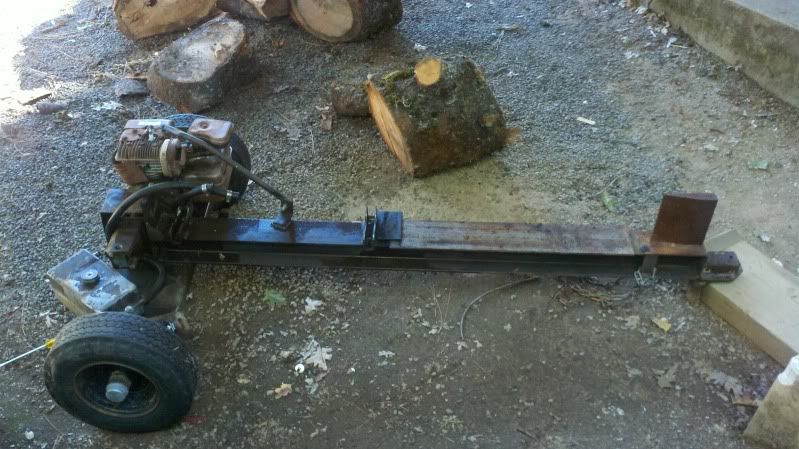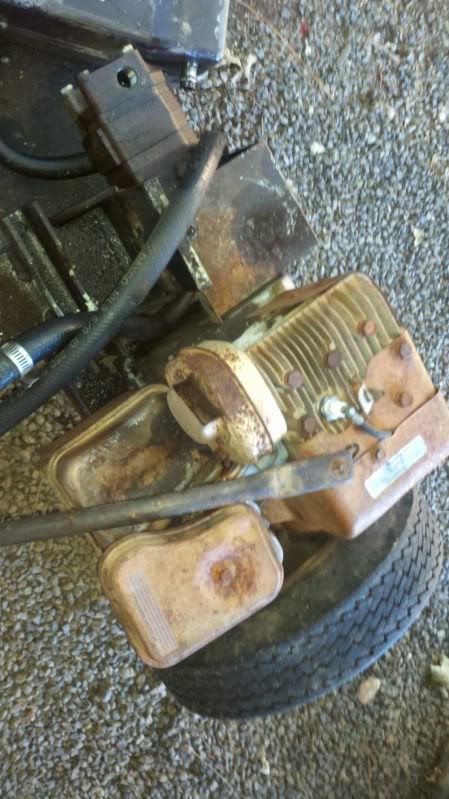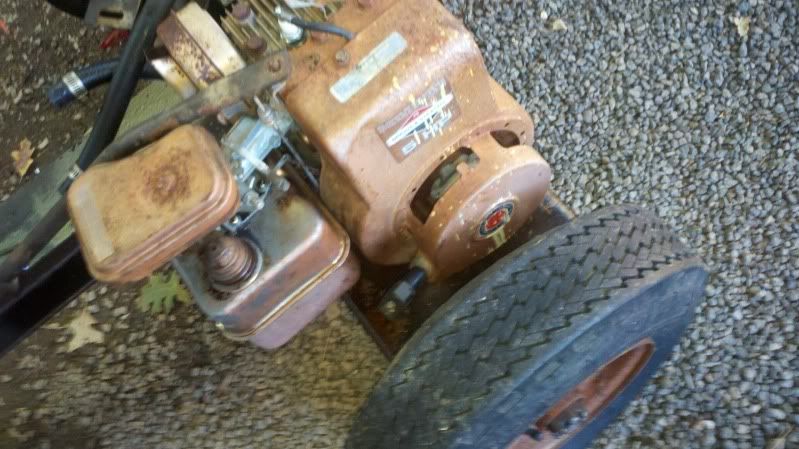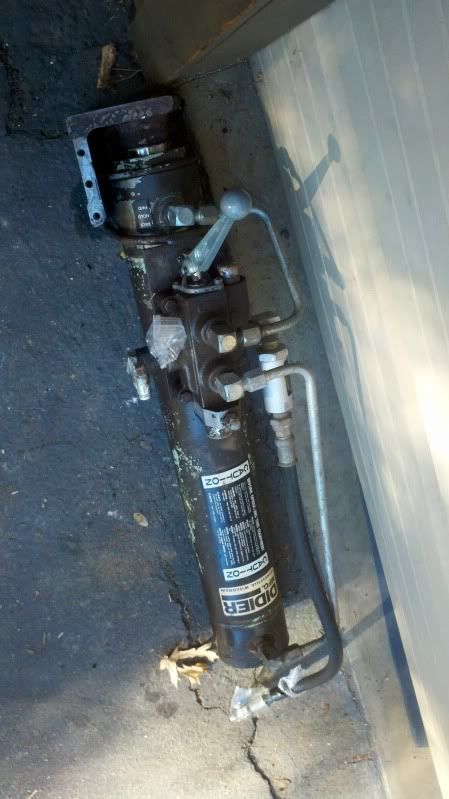There is always the question of the break even point. I just ordered $40 or so in parts for the engine. Replacing it for $130 sounds like the financially responsible thing to do. After all, it shouldn't cost more to maintain an engine than it does to buy one new.
You are using an out of date browser. It may not display this or other websites correctly.
You should upgrade or use an alternative browser.
You should upgrade or use an alternative browser.
Didier splitters
- Thread starter Wife'nHubby
- Start date

Help Support Arborist Forum:
This site may earn a commission from merchant affiliate
links, including eBay, Amazon, and others.
Cigarman
ArboristSite Lurker
There is always the question of the break even point. I just ordered $40 or so in parts for the engine. Replacing it for $130 sounds like the financially responsible thing to do. After all, it shouldn't cost more to maintain an engine than it does to buy one new.
I got lucky!
I just recently bought my Didier, but it had a new 8.75 HP Briggs and Stratton on it!
The thing cranks.
The only reason I said what I did, about just replacing the motor was, that it sounds like you are chasing a fix by purchasing parts.
I find it's always best to just bite the bullet and replace something if you aren't exactly sure what the issue is.
If you can get the parts cheap then it doesn't hurt to chase a fix, However...
When looking around at engines I found some higher powered ones cheaper than the 5hp. I was wondering if getting a bigger engine (like your 8.5hp) would be a bad idea. Would it create too much pressure and break the hydraulics, for example?
Iron man
ArboristSite Operative
Hi To All,
For the life of me, I could not figure out how to load the actual photos...
Hopefully I have done it!
See new Northern Hydraulics 4" x 24" cylinder installed on my splitter. $160
Mark



You break those welds at the push plate?Ive never had any luck welding cast steel but I have heard with the right techniques it can be done.
When looking around at engines I found some higher powered ones cheaper than the 5hp. I was wondering if getting a bigger engine (like your 8.5hp) would be a bad idea. Would it create too much pressure and break the hydraulics, for example?
A bigger engine in it self will not produce more pressure unless you increase the relief setting on the control valve. If the relief setting is increased beyond the rating of the other hydraulic components than a failure is possible.
Markjewell
ArboristSite Lurker
Push Plate Weld
No problems MIG welding the push plate. I had cut the clevis in half and matched it right up against the pushlate. Not much stress here as you are only applying pressure in a forward direction. The new hardened brass guides that I had machined keep the pushplate true on the rail.
Mark
You break those welds at the push plate?Ive never had any luck welding cast steel but I have heard with the right techniques it can be done.
No problems MIG welding the push plate. I had cut the clevis in half and matched it right up against the pushlate. Not much stress here as you are only applying pressure in a forward direction. The new hardened brass guides that I had machined keep the pushplate true on the rail.
Mark
So now I'm more seriously shopping for a new engine. Not wanting to dump money into a 30+ year old motor with many hours on it. The names I'm most familiar with are B&S, Honda and Kohler. It seems a lot of the engines are no longer rated by HP, but now use torque or CCs. It looks like I would need something around 200cc or 9.0 torque, horizontal 3/4 shaft. There can be quite a range in price. What do all of you find to be best use of your $$$? I'm scared of the no-name brands (or Harborfreight), because I could just be shifting one set of problems for another. I don't want to drop a lot of money into this project, but I also don't want to get an engine that will need me to baby it and fix it all the time. Some of the off brands are difficult to work on or repair. Lack of information out there as well as a tough time finding parts.
What are your recommendations?
Right now I'm eyeing this one:
Kohler 6.5 HP Horizontal Engine 196cc, 3/4in. x 2 7/16in. Shaft, Model# PA-SH265-0011 | 241cc - 390cc Kohler Horizontal Engines | Northern Tool + Equipment
But I'd be happier finding something under $200.
Brokk...
What are your recommendations?
Right now I'm eyeing this one:
Kohler 6.5 HP Horizontal Engine 196cc, 3/4in. x 2 7/16in. Shaft, Model# PA-SH265-0011 | 241cc - 390cc Kohler Horizontal Engines | Northern Tool + Equipment
But I'd be happier finding something under $200.
Brokk...
bigblock73
ArboristSite Lurker
Well, my parts came in to rebuild my carb, so I decided to give this engine one more shot. However, I wanted to get spark first before I went any further.
I went out and bought the "proper" spark plug for it (RCJ8), and took it home. I know the armature is doing something, because I can put my finger between the spark plug connector and the block and I get a zap when I pull the cord. I put the new spark plug in and I still get no spark. However, I put it into the engine, screw it down tight and give it a dozen good pulls and she tries to start. A few more good pulls and eventually she does start, then stalls back out before she warms up. So I'm getting something.
Is it possible there is something in the ignition/spark process that is too weak? Could that be the cause of my issues (running rough, build up of black slimy stuff inside the cylinder, etc)?
I'm going to clean out the cylinder again (I have a new head gasket this time), and I'm going to rebuild the carb since I have the parts. Hopefully it will run good after this. If not, I'm not sinking another dime into it. I'll be going out to buy a new engine.
Brokk...
I went out and bought the "proper" spark plug for it (RCJ8), and took it home. I know the armature is doing something, because I can put my finger between the spark plug connector and the block and I get a zap when I pull the cord. I put the new spark plug in and I still get no spark. However, I put it into the engine, screw it down tight and give it a dozen good pulls and she tries to start. A few more good pulls and eventually she does start, then stalls back out before she warms up. So I'm getting something.
Is it possible there is something in the ignition/spark process that is too weak? Could that be the cause of my issues (running rough, build up of black slimy stuff inside the cylinder, etc)?
I'm going to clean out the cylinder again (I have a new head gasket this time), and I'm going to rebuild the carb since I have the parts. Hopefully it will run good after this. If not, I'm not sinking another dime into it. I'll be going out to buy a new engine.
Brokk...
Cigarman
ArboristSite Lurker
I had an issue like this with a motor that was on my Uncles wood splitter. I looked at the gas line and it was dry rotted. I replaced the gas line hoses and it ran just fine after that.
If it isn't the gas line then it's probably a carburetor issue.
If it isn't the gas line then it's probably a carburetor issue.
Well I cleaned out the carb (20 min soaking), rinsed it off, blew it out with compressed air, put it all back together with the new parts. Cleaned the cylinder and valves, put that back together with a new gasket. Hooked it all up, and damned if I couldn't get it started. I tweaked, nudged for all I was worth, but could not keep it running for more than a few seconds. Eventually I, pulled off air element and sprayed in some engine starter. Finally got it running. Then tweaked some more until it seemed to be running solid.
Still tough to start. Should start on one or two pulls. In reality it takes me about 8-10 pulls and then it's real reluctant. I'm still having that issue when you bump into the machine, it splutters and makes noises about wanting to stall. Any demand on the motor (using hydraulics) and it starts to run rough. After it's warmed up (about 5+ minutes) and it smooths out and seems to run OK, as long as there are no bumps or vibrations. I split wood for about 15 minutes, just to see how it runs. Seems shaky, but OK. It didn't die on any of the wood, but I didn't have anything really rough to split on hand. I tried shutting it off, then starting it again. Still hard to start, even with a warm engine. Took 1/2 dozen pulls.
I did a quick check early on by pulling the spark plug out. No greasy black stuff. So that's good. Forgot to check when I was done with my 15 min test though.
The predator engine was on-sale, with today being the final day, so I decided to stop screwing around with the old engine and replace it with another for under $100. Now to do the work of pulling off the old and putting on the new.
For those of you who have gone through this process of replacing the motor, did you need to make any odd modifications, such as attaching that arm to the top of the new motor to cut down vibrations?
Still tough to start. Should start on one or two pulls. In reality it takes me about 8-10 pulls and then it's real reluctant. I'm still having that issue when you bump into the machine, it splutters and makes noises about wanting to stall. Any demand on the motor (using hydraulics) and it starts to run rough. After it's warmed up (about 5+ minutes) and it smooths out and seems to run OK, as long as there are no bumps or vibrations. I split wood for about 15 minutes, just to see how it runs. Seems shaky, but OK. It didn't die on any of the wood, but I didn't have anything really rough to split on hand. I tried shutting it off, then starting it again. Still hard to start, even with a warm engine. Took 1/2 dozen pulls.
I did a quick check early on by pulling the spark plug out. No greasy black stuff. So that's good. Forgot to check when I was done with my 15 min test though.
The predator engine was on-sale, with today being the final day, so I decided to stop screwing around with the old engine and replace it with another for under $100. Now to do the work of pulling off the old and putting on the new.
For those of you who have gone through this process of replacing the motor, did you need to make any odd modifications, such as attaching that arm to the top of the new motor to cut down vibrations?
Cigarman
ArboristSite Lurker
Glad to hear you bought a new motor. It seemed like the thing to do. When I bought mine the motor had been replaced and the vibration arm was zip tied to the machine but not attached.
So, I'd say you don't need it anymore. Mine runs fine without it.
So, I'd say you don't need it anymore. Mine runs fine without it.
Motor is mounted. It was much easier than I expected. Now I just need the right oil to fill it up with and I can try it out.
There was only one issue to speak of. The shaft length on the new motor was about 3/8" shorter than the old one. Which meant the connection to the hydraulic shaft was not perfect. I loosened both sides and slid them together, so they shared the difference. Neither shaft goes to the very end of the fitting (less than a 1/4" short). Should that work OK?
My other option is the pull the motor back off and take a drill to one set of holes on the log splitter, so I can slide the motor a little closer (the other set of holes on the motor side is wide, which allows for some variance.
There is no place I can attach the vibration arm on the top. There are three big items up there. Gas tank, muffler and air filter. None of those are good candidates for attaching a firm bolt to hold the engine steady with. There is a place near the bottom I might make something work, but what's the point down there, as there are already four bolts holding it to the splitter frame.
I'll run out tomorrow morning for the oil so I can try it out!
There was only one issue to speak of. The shaft length on the new motor was about 3/8" shorter than the old one. Which meant the connection to the hydraulic shaft was not perfect. I loosened both sides and slid them together, so they shared the difference. Neither shaft goes to the very end of the fitting (less than a 1/4" short). Should that work OK?
My other option is the pull the motor back off and take a drill to one set of holes on the log splitter, so I can slide the motor a little closer (the other set of holes on the motor side is wide, which allows for some variance.
There is no place I can attach the vibration arm on the top. There are three big items up there. Gas tank, muffler and air filter. None of those are good candidates for attaching a firm bolt to hold the engine steady with. There is a place near the bottom I might make something work, but what's the point down there, as there are already four bolts holding it to the splitter frame.
I'll run out tomorrow morning for the oil so I can try it out!
Wife'nHubby
Addicted to ArboristSite
I can't answer your first question but regarding the vibration arm - I removed mine - in my case it was not needed with the replacement motor we put on.
Shari
Shari
bigblock73
ArboristSite Lurker
I couldn't find a good place to mount the bar, so I left it off.
So far, So good
So far, So good
So far, so good. It's running well. There is not a set idle, so I have to play around with that a bit. Depending on where I idle it, it can vibrate all over, or hardly vibrate at all. Right now I'm running the idle pretty low (least vibration). So far, it's split everything I throw at it, with no hint of wanting to stall. I'm guessing a lower idle is OK, since it's a higher HP than the original B&S (6.5 rather than 5). If I could hook up the vibration arm, I would run a higher idle. Any thoughts on whether higher or lower idle is better for it?
One modification I did make was to add an exhaust "shield". The muffler is pointed right where I sit when splitting, so I'm sucking in major fumes. Not healthy. So I used some sheet metal to redirect it to the side. It's not perfect, and the air cleaner is likely pulling some in now, but it's better than it was, for me at least.
One modification I did make was to add an exhaust "shield". The muffler is pointed right where I sit when splitting, so I'm sucking in major fumes. Not healthy. So I used some sheet metal to redirect it to the side. It's not perfect, and the air cleaner is likely pulling some in now, but it's better than it was, for me at least.
Cigarman
ArboristSite Lurker
I have the same issue with the muffler pointing right at the control valve area. What I did was move to the other side of the splitter to work. It is much better working on that side, fumes wise.
You shouldn't need the vibration arm if your motor is mounted tightly to the frame of the splitter. My motor is a Briggs and Stratton 8.75 HP and I run it full out. I read somewhere that it is not good to fun these motors at anything other than full for long periods of time (which is what you're doing when using the splitter). I cannot remember where I read it but I'm pretty sure it was in a splitter motor replacement thread.
Apparently the different HP doesn't really affect how the pump works.
You shouldn't need the vibration arm if your motor is mounted tightly to the frame of the splitter. My motor is a Briggs and Stratton 8.75 HP and I run it full out. I read somewhere that it is not good to fun these motors at anything other than full for long periods of time (which is what you're doing when using the splitter). I cannot remember where I read it but I'm pretty sure it was in a splitter motor replacement thread.
Apparently the different HP doesn't really affect how the pump works.
jeffrm20
New Member
Howdy everyone, got a Didier from a friend dirt cheap. Sat for 5 or so odd years. When I got it, it didn't run. Cleaned all the surface rust off of the magneto and flywheeel. She started right up. My problem is, that I have a major seal leak on the ram. Could someone provide me with a seal kit part number so I can get this fixed before winter hits. Not ready for the snow!
Thanks.
BTW this thread has been super useful!
Jeff
Thanks.
BTW this thread has been super useful!
Jeff
jeffrm20
New Member
Here is my splitter, got the ram off this morning. Getting ready to disassemble it.
Surprisingly this motor still runs like a champ!




Surprisingly this motor still runs like a champ!




Wife'nHubby
Addicted to ArboristSite
Jeff -
If you read through all the threads, you will realize Didier is no longer made so part numbers don't really help. The consensus of the group has been to remove the cylinder and, if you can, take it to either a hydraulics store or a farm impliment store (which is what I did) and they should be able to get you the parts or even do the repair.
Happy splitting!
EDIT: PS If you want the manuals I have in .pdf file format, click on my name in the box at the left and send me you email address via a pm. The list won't allow sending files directly to the list.
Shari
If you read through all the threads, you will realize Didier is no longer made so part numbers don't really help. The consensus of the group has been to remove the cylinder and, if you can, take it to either a hydraulics store or a farm impliment store (which is what I did) and they should be able to get you the parts or even do the repair.
Happy splitting!
EDIT: PS If you want the manuals I have in .pdf file format, click on my name in the box at the left and send me you email address via a pm. The list won't allow sending files directly to the list.
Shari
Similar threads
- Replies
- 2
- Views
- 312
- Replies
- 8
- Views
- 1K
- Replies
- 0
- Views
- 768
- Replies
- 0
- Views
- 651
- Replies
- 1
- Views
- 889
Latest posts
-
Stihl MS 170 / 180 Chainsaw - Adjustable Carburetor Swap Tutorial
- Latest: Vintage Engine Repairs
-
-
-
Scrounging Firewood (and other stuff)
- Latest: SS396driver
-
-
-



